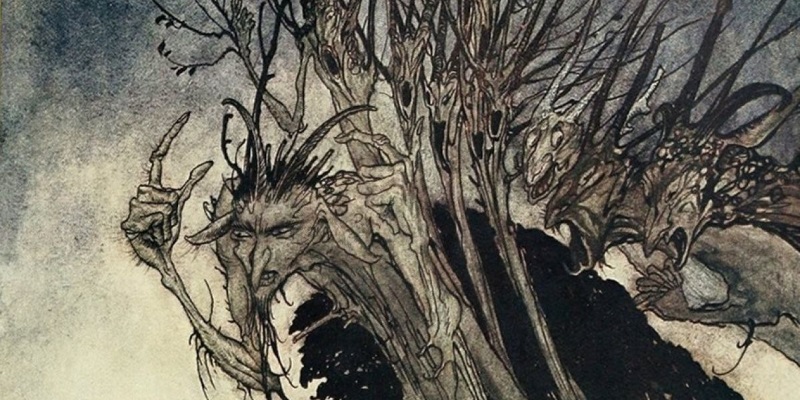The Schemes of the Archfey, Part Two

Last time in my series of articles on the fey, I presented story hooks for the first five Archfey. Now I’m going back to that topic, with story hooks and interactions for the Green Man, the Night Collector, the Sea Hag, and the Thornweaver. Though three of the four are Unseelie, I’m still avoiding things like “go beat this Archfey to death,” because I figure that anything that obvious, you can handle on your own.
Fey Chivalry | Fey Huntsmen and Leashed Terrors | Faerie Tales: Naiads, Pixies, and Sprites for 5e | A Visit to the Shadowfell – Shadar-Kai & More | In a Goblin Market | Fey of the Elder Starlight | Fey Enchanters and Their Lairs | Treasures of a Fey Market | Archfey Patrons | Archfey Patrons, Part Two |Archfey Patrons, Part Three | The Schemes of the Archfey | The Schemes of the Archfey, Part Two
The Green Man
The Green Man is generally benevolent toward mortals, and his approach to the world is (intentionally or incidentally, as you prefer) about making it more habitable for them. How do we tell stories that involve the Green Man and some conflict?
- If you’re really good at something, never do it for free. The Green Man and his servants are willing to counter the blight that is starving the kingdom. They didn’t cause it, but they’re willing to use it as leverage to get what they want. Specifically, they would like some of the Thornweaver’s warlocks driven out of an ancient temple. The Green Man and the Thornweaver are natural enemies, basically interested in using the same materials toward opposite ends.
- In my campaign, the Green Man is currently dead, and has been for an unstated but long time. Some of the fey are trying to build an orichalcum machine that should resurrect him. It’s creating competition between different Seelie factions, all of which want to take credit for restoring the Seelie Queen’s consort.
- As Royal Consort, the Green Man is forever engaging the Seelie Queen’s attention with trifling games and wagers. Their influence usually has to be indirect, and it’s often about setting up and resolving one or more romantic triangles. As I mentioned for the Seelie Queen, it can be hard to handle romance convincingly at the table, so maybe the fey are sending the mortals on increasingly bizarre and difficult quests, all so they can get that person out of the way in favor of a different romantic partner.
The Night Collector
Because of her mercantile role, the Night Collector is nearly a free agent within the Courts. She often uses the possibility of switching Courts as a lure to one side or the other. To convince the ancient and subtle Archfey, of course, it is necessary that she believe she’s telling the truth at the time – that she really might abandon the Unseelie if she were given the proper motivation. She’s obliged, then, to keep the threshold of “sufficient motivation” nebulous, something of a moving target.
- In Shattered Isles, for example, my character was trying to free the Night Collector from her connection to the Shadow Court (it’s the one that’s actually-super-evil – alternate Courts and court alignments are a future article in this series). This got my intensely goodly character involved in all sorts of bad ideas, on the belief that he could get her out of this debt and bring her into the Unseelie Court. (Getting her to become Seelie was never even on the table.) I don’t really know the details of the NPCs’ plans, but getting me to accept gifts of power and trade in information – basically, turning me into an intelligence asset – seems to have been the general tenor. For what it’s worth and as far as I know, I actually succeeded in my goal.
- She wants unique but often intangible things in exchange for rare things that can be duplicated. What would she do if someone weaseled out of a deal with a remove curse, greater restoration, or similar magic? She wouldn’t get her own hands dirty, not when she could get her hooks in someone by hiring them to do it. Now, hiring mortals to be her debt collectors doesn’t always work well, so maybe she pitches it as passing someone else’s intangible thing (their luck, their voice, their memory of their mother) on to the adventurers, who can then do whatever they want with it. That mixes just enough “but we get to help someone in need” into the deal that they might think, “Yeah, okay, this person is welching on a deal, they deserve what we do to them.”
- Another of her best situations is when an awful fate looms over someone, the clock is ticking, and there’s a piece of information (like the location of a treasure) that the heroic types desperately need. Enhanced interrogation doesn’t really work on Archfey, so you’re either playing her game or you’re pursuing the information the slow, methodical, probably-too-late kind of way. It’s a maximum-profit, minimum-effort kind of situation, when she can set it up.
- There are a lot of Sea Hag types who tread on the same general patterns. (Hans Christian Andersen wrote a story to revive Disney’s animation studio, you might have heard about it.) Anyway, the Night Collector and the Sea Hag are often at odds within the Unseelie Court, because the Night Collector gets to have it all: cushy position at Court, actively sought out by Seelie and Unseelie alike, dark and mysterious nature. What does the Sea Hag get? Something close to exile from Court, ill regard, and an eternity of clawing for every scrap.
The Sea Hag
So about that Sea Hag. The thing that makes her so incredibly dangerous is that her power base isn’t in the Feywild (probably) – it’s in the 70% of the world that is covered in seawater. Oceanic storms are deadly even in a modern tech axiom; in a classical, medieval, or early modern setting, sea travel is one of the scariest things that someone might do for a living.
- Fail to placate her, and she’ll kill everyone on your ship. This could make a great social investigation sequence: the Sea Hag’s storm is approaching and threatens to capsize the ship the PCs are on. Someone on the ship angered the Sea Hag (possibly by refusing a deal and accepting a better offer from the Night Collector), and the PCs need to figure out who it is and either throw them overboard or set things right before the Sea Hag casually sinks the whole ship. Proportional response is not her deal.
- She has a lot in common with cruel sea goddesses, such as Umberlee of Forgotten Realms, but she’s not divine as such. Since both sides are invariably characterized as jealous in the extreme, there is probably endless infighting between the parts of the sea where the Sea Hag and fey-logic hold sway, and places where the sea goddess has driven out all of the fey. Neither side is the least bit benevolent to seafarers, you’ll note – but that could shift abruptly if one of them is getting the worse end of a fight and needs new allies.
- Either that, or one kills the other outright and masquerades as her. Once that gets revealed, it sends shockwaves through the heavens, the hells, and the fey courts. If the Sea Hag was the victor, she doesn’t have the divine rank to grant spells to all of her clerics, so she’s probably had a huge shakeup in the faith to justify denying spells to many of her clergy while she consolidates her power and seals new bargains. If the sea goddess won out, she commands water-dwelling fey to do things that are grossly out of character for them, but in line with her momentary needs. She’s comfortable sacrificing them en masse, if there’s any chance of gain.
The Thornweaver
What the Thornweaver wants from the world is to sit on a throne in a forest, be marvelously decadent, and watch a lot of horrific torture and blood sacrifice take place. He wants to be a tyrant in a very specific color palette. He wants this because he knows he’s just as good as the Green Man, but he can’t seem to win the recognition and credibility necessary to be the royal consort to the Queen of Air and Darkness. (It doesn’t help that his goal is only attainable in the seasons of the year when his Court is weakest.)
- Whenever you’re exploring an ancient ruin in a forest, swamp, or jungle, the Thornweaver takes an interest in it either shortly before or shortly after you start your exploration, turning your conflict there into a three-way fight. The Thornweaver always wants more out of the situation than you’re willing to give – if you are fine with surrendering the ruin to him after you’re done, instead he wants you to stay for drinks. Well, as drinks, for his plants. Same thing.
- Now, everyone knows that a sorcerer’s power is bound in the blood. Only the Thornweaver takes the next step of that logic and introduces sorcerous blood into non-sorcerous individuals – first as an experiment, then as a way to create a force of arcane spellcasters who are deeply in his debt. Where did he get the blood in the first place? Maybe there’s a green dragon who slumbered too long in a forest that the Thornweaver took over, and now it is ensnared in his vines.
- Just as sea goddesses and the Sea Hag contend for territory, the Thornweaver contends with gods of the forest and growing things. (The Green Man does too, for that matter.) Only a severely debased druid finds the Thornweaver’s practices acceptable, but he is happy to reward them for their services, usually with fey beasts or consorts.
- If you’re obsessed with blood and decadence, there’s only one thing that can complete your collection: the skull of someone really important, as your drinking-vessel. Maybe that means hiring people to rob a royal crypt. Or maybe the prince has been called to a tryst with his lover in the forest, and brings the PCs along to make sure he gets there and back safely and discreetly – only to reveal that his beloved was never there, and it was all an Unseelie ruse to claim his skull.
In the next fey article, I’ll cover the last five Archfey. Thanks to one reader’s article prompts, I’ll also eventually write about enchanted weapons of the fey and alternate Courts and court alignments. Thanks for reading, and I hope these story hooks spark some ideas for you!



